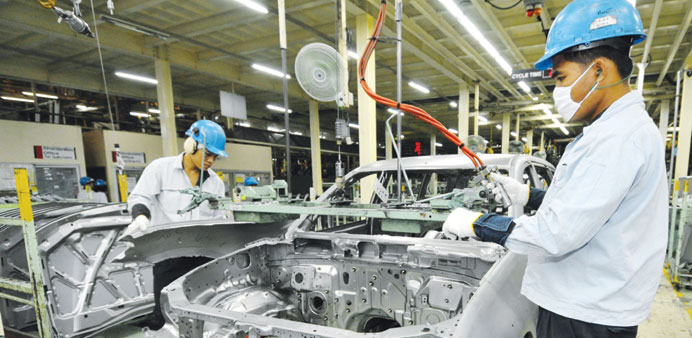Workers assemble a car at a Mitsubishi Motors plant in Laem Chabang, Thailand. The country’s shipments of key industrial goods fell 7.7% in June from a year earlier, with vehicles and parts down 17.7%.
Reuters
Bangkok
Thailand’s exports tumbled more than expected in June, indicating the country’s weaker currency is not yet helping fire up the country’s traditional long-stalled growth engine.
Exports, which equal more than 60% of the economy, dropped 7.87% in June from a year earlier, the commerce ministry said yesterday.
That was the biggest drop since late 2011 and more than the 5% decline seen in a Reuters poll.
Trade is the first of piece of June data. Others due this week are also expected to show Thailand continues to struggle to raise growth.
The ministry maintains that exports can expand 1.2% this year. The central bank sees a 1.5% fall. Exports fell in 2013 and 2014. Charnon Boonnuch, economist at Tisco Securities, said while June exports fell more than expected, “exchange rates will be a positive factor helping them in the second half.”
The baht has lost about 5.5% against the dollar this year. A weaker baht will help exports and provide more of a boost to the economy than a rate cut, Deputy Prime Minister Pridiyathorn Devakula said this month.
In June, exports to the US slipped 0.1% from a year earlier, while ones to China were down 0.8%. Shipments to Japan were down 4.2% and to Europe by 7.1%.
Shipments of key industrial goods fell 7.7% in June from a year earlier, with vehicles and parts down 17.7%. Imports in June slipped 0.21% from a year earlier, against the 7.7% fall in the poll. In May, imports collapsed 19.97%, their biggest fall on an annual basis since August 2009.
Many of Thailand’s imported materials are assembled into completed goods and shipped out again.
Imports of fuel fell 7.1% due to lower oil prices, and while those of capital goods rose 2.65%.
The central bank next reviews monetary policy on August 5. Most economists expect no change in the policy rate, now 1.50%. The army took power in May 2014 to end political unrest but has been unable to revive Southeast Asia’s second-largest economy.
Growth last year was just 0.9%. Last month, the central bank cut its 2015 forecast to 3% from 3.8%, with a downside risk.



